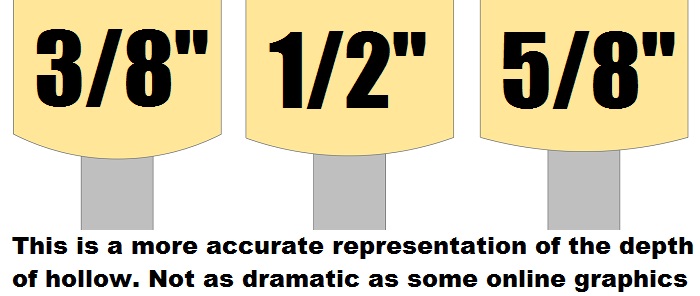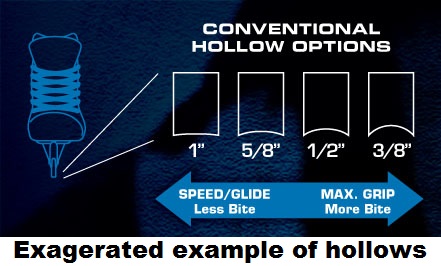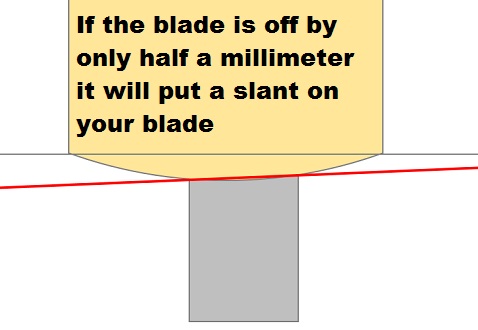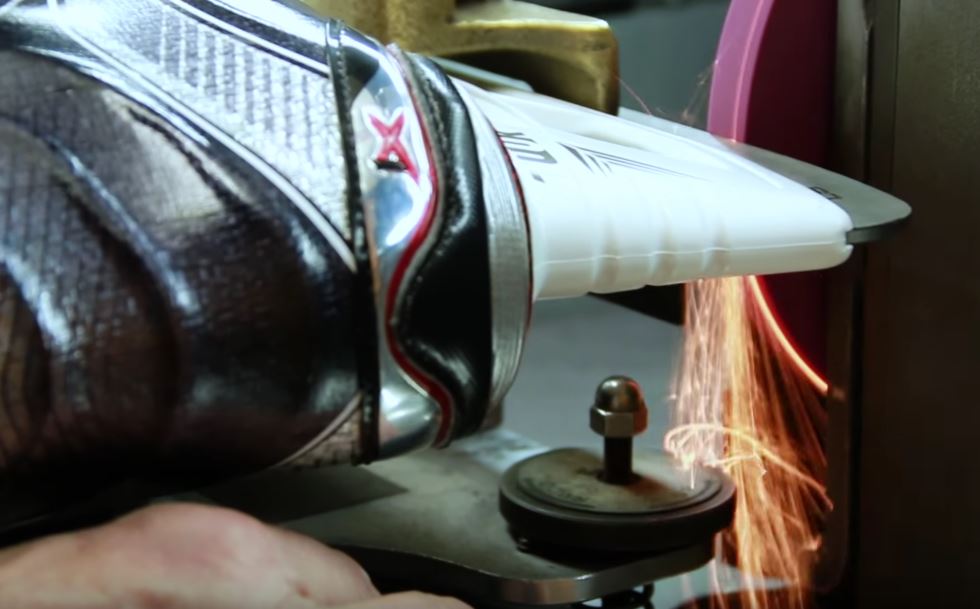
So there are a lot of articles about sharpening out there. Some go into great detail to explain everything that could possibly be relevant to sharpening your skates, some are more general. This one is intended to act as a “beginner’s 101 guide,” which will ensure you will:
- Understand what the shop is actually doing when they sharpen your skates
- Be able to identify some of the potential problems in the way your skates are being sharpened
- Have a starting point in customizing your skate sharpening (specifically the hollow)
The process of sharpening – how it works
If you’ve ever looked closely at the bottom of your skates, you’ve noticed that each blade has not one edge like a knife or an axe, but rather two, connected by a hollowed-out region in between. This shape is created by passing the blade along a grinding wheel (often called a finishing wheel). If you were to break this wheel into two semicircular pieces, you’d notice that the cross sectional edge is rounded, like a segment of a circle. Passing your skate runner along the wheel, parallel to the direction of the wheel’s travel, will impart this rounded shape into the bottom of your blade. Your skate is clamped into a jig (most commonly one that holds the blade horizontally) which is aligned with the finishing wheel. The blade is then gently passed along the finishing wheel about 10 times, until the edges are sharp and the bottom is fully hollowed out.
Prior to the finishing wheel, it is sometimes necessary to use an additional wheel, called a cross-grinder, to prep the blade for finishing. Unlike the finishing wheel, the cross-grinder runs perpendicular to the skate blade, is designed to dull and flatten the blade rather than sharpen it, and it has much more bite than the finishing wheel. It’s most commonly used to “reset” the blade to a blank state, ready to be re-finished. This is an unnecessary step for most sharpenings, but is great at removing defects such as bad sharpenings, major pockmarks/burrs, and rust. It’s also used whenever a skate is being sharpened for the first time.
Customizing your sharpening
There are a few aspects to skate sharpening that can be customized, the most common of which is the hollow. As mentioned earlier, sharpening your skates involves passing them over a spinning stone with a rounded outer surface. This surface can be modified to have a very curved surface resembling a segment of a small circle, or it can be flatter, resembling part of a larger one. Altering the shape of the wheel’s surface will alter the size of the hollow it imparts on your skates.
This “segment of a circle” – its size in particular – is how we describe the hollow on skates. Each amount of hollow corresponds to a wheel that has been profiled so that its cross-sectional profile would fit onto a circle with a certain radius. A larger radius will mean a flatter grinding wheel, and therefore a skate with less hollow cut away from its centre. The normal range for this is ⅜” to ¾”, although higher or lower hollows are occasionally seen. Typically, skate shops will do 1/2”, 5/8”, or 7/16” hollow as a default if they aren’t given any specific instructions. In the pictures here, you can see what these hollows look like when viewed up close.
Unlike many other images floating around which exaggerate the differences between one hollow and another, these ones are 100% accurate and properly drawn to scale, with the ratio between the 3mm thick blade and ½” wheel profile being preserved.
We do this because each hollow will affect how the skate feels, and how it interacts with the ice. Deeper hollows will put more pressure on the edges of the blade and dig into the ice more. Shallow hollows will do the opposite. They distribute pressure more evenly throughout the blade, causing them to sit more on top of the ice.
How Hollows Affect Your Game
- Smaller radius of hollow (eg. ⅜”)
- Deeper cut on skates
- Better suited to lighter players who dig in less to start with
- More energy lost into ice
- Extra effort required to skate
- Lower top speed
- More responsive turns and stops
- Quicker, more explosive acceleration
- Larger radius of hollow (eg. ⅝”)
- Flatter cut on skates
- Better suited to heavier players who have no trouble gripping the ice
- Less energy lost into ice
- More efficient skating
- Faster top speed
- Turns and stops will be less quick or sharp
- Acceleration is more limited
Other ways to customize your skate blades exist as well (eg. profiling the blade shape). However, these are beyond the scope of a typical beginner’s needs.
Major sharpening issues and how to catch them
Here, “major issues” refers to things that make your skates effectively unusable until the problem is fixed. There are two common major issues that can do this. In either case, the only solution is to get your skates re-sharpened, ideally somewhere that does a better job.
- Improper alignment:
- This happens when the sharpener didn’t properly align your skate blade with the grinding wheel. It causes one edge to be taller than the other.
- Skates will have plenty of bite when turning/stopping in one direction, but will feel like they’re slipping out when going the other way.
- When looking down the length of the blade, you’ll see one edge is higher than the other. If you balance a coin or other flat object on the top of the blade, you may notice it’s tilted as well.
- Not fully sharpened:
- This is when your skates are cross-ground (either partially or fully) but then not completely hollowed back out. Skates will have very little bite in every direction, making it tough to push, turn, stop, or do much of anything. This is because the blade was flattened from the cross-grind wheel, but the sharpener didn’t pass it over the finishing wheel enough times for it to regain its edge. Effectively, you’re skating on a skate that is still cross-ground.
- When looking at the bottom of the blade, you’ll see two thin lines running down the edges with a slightly different “sheen” or color. Sometimes you need to hold the blade up to a light source and tilt back and forth to see.
- If you only notice this appearance on one edge of each blade, your skates were not fully sharpened and improperly aligned.
Minor sharpening issues to watch for
These problems won’t make it impossible to skate, but they’re still worth knowing about. If you’re noticing that they’re happening, it can mean your hockey shop isn’t putting very much effort into sharpening, which increases the chance they’ll make bigger mistakes from time to time.
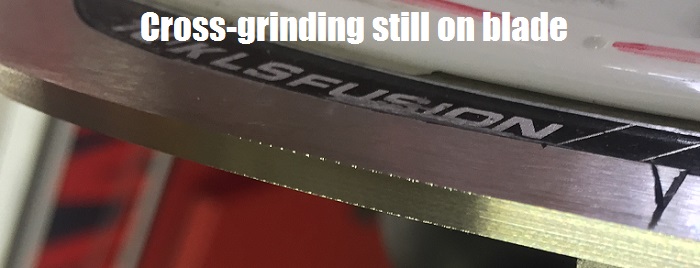
- Unnecessary cross-grinding
- Cross-grinding is an excellent way to prep brand new skates for sharpening, or to remove rust or other imperfections (eg. uneven edges) left over from a previous sharpening. Unlike the finishing wheel, the cross-grind wheel runs vertically (perpendicular to the skate blade), so it doesn’t impart its shape onto the blade. It’s also much coarser, making it able to chew through the blade much faster. Effectively, it “resets” the blade to be completely flat on the bottom, ensuring the it can be perfectly aligned with the finishing wheel, even if it was previously crooked or uneven.
- However, it also removes much more steel from the blade than the finishing wheel. If your hockey shop is doing a full cross-grind every time they sharpen, then your blades will have a lifespan of about ⅓ of what they’d have without cross-grinding. As a compromise between precision and blade life, some shops will do an extremely light cross-grind to take off only the edges, without removing the entire hollow.
- Over-sharpening the tip & tail
- A hockey skate is designed to be relatively (but not entirely) flat in the middle two-thirds of the blade, and rockered at the ends for agility. Maintaining this profile requires a very light touch. Not only that, but the wheel should be spending nearly all its time within the middle two-thirds of the blade. Trying to pass the wheel along the entire length of the blade will cause it to gradually become more and more rockered over time.
- Too hard & too fast
- To give the blade a nice, smooth edge, your sharpener should be passing it over the wheel slowly but lightly. Going too fast (especially on the final few passes) can create burrs and rough spots along the edges, while pressing too hard can cause the blade to “chatter” on the wheel, making it discolored and slightly uneven.
Other common questions
- How often should I sharpen my skates?
- This is a very personal call. Some players will sharpen very frequently, such as every 2-3 hours of ice time, while others go for an entire season without sharpening. If you’re unsure of where to start, try getting them sharpened after 10 hours of ice time, and then adjust as you feel is necessary.
- It’s also worth noting that colder ice (especially the type found outdoors) is much harder, and will dull your skates very quickly. If you’re playing with your buddies on the outdoor rink, it’s probably a good idea to get a sharpening before your next game.
- What should I be doing to maintain my skates in between sharpenings?
- A honing stone is a great choice for maintaining your blades. Its job is to smooth out any burrs or nicks that can form on the sides of your blades, which can catch the ice and slow you down.
- Although tempting, re-edging tools (such as the sweet stick) cannot and should not replace regular sharpenings. They should be used for the occasional touch-up only, if you’re unable to get your skates sharpened before your big game. This is because they don’t hollow out the bottom of the blade the way an actual sharpening wheel would. Instead, they scrape away at the outsides of your blades, tapering them in to create a temporary edge.
- I’ve heard of a new sharpening style called Flat Bottom V (FBV). What is this, and how well does it work?
- FBV is similar to a traditional sharpening in the sense there’s still a grinding wheel which the skate blade is passed along. But instead of a round profile, the wheel is now flat in the center and cut away further out, where the edges of the blade will be. This makes your skate blade’s cross-section flat in the middle and angled into the ice along the edges. It’s intended to give the user more glide without sacrificing bite as much as a traditional sharpening would. Everyone seems to have their own opinion on it – some users find it to be largely the same as a traditional hollow, while others find it greatly improves their game. I would encourage you to try it out and form your own opinions.
